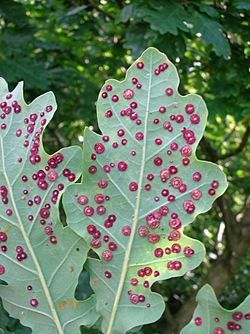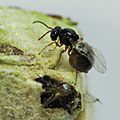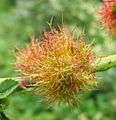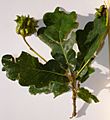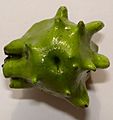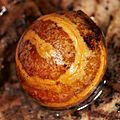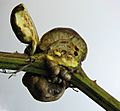Gall wasp facts for kids
Quick facts for kids Gall Wasps |
|
|---|---|
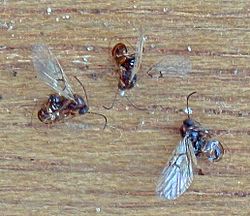 |
|
| Neuroterus albipes, parthenogenetic generation females, from galls on Quercus robur | |
| Scientific classification | |
| Kingdom: | |
| Phylum: | |
| Class: | |
| Order: | |
| Suborder: | |
| Family: |
Cynipidae
|
Gall wasps, also called gallflies, are small insects. They belong to the family Cynipidae. These tiny creatures are part of the Hymenoptera order, which also includes bees and ants. There are about 1300 known species of gall wasps around the world. They are usually very small, only 1 to 8 millimeters long. In Europe, you can find about 360 species, and in North America, there are around 800 species.
Contents
Plant Galls: Homes for Gall Wasps
Most gall wasp larvae grow inside special bumps on plants called plant galls. The female gall wasp lays her eggs on a plant. After the eggs hatch, the tiny larvae start to grow. As they grow, they cause the plant to form a gall around them.
Scientists are still learning exactly how these galls form. The larvae eat the nutritious tissue inside the gall. This gall also acts like a safe house, protecting them from bad weather and other dangers.
About 70% of all known gall wasp species live on oak trees. You can find galls on almost any part of an oak tree. They appear on the leaves, buds, branches, and even the roots. Other types of gall wasps live on eucalyptus trees, rose bushes, maple trees, and many other plants.
Reproduction and Life Cycle
Most gall wasp species have a special way of reproducing. It's called an alternation of generations. This means they have two different generations each year. One generation includes both male and female wasps. The other generation is made up only of females, who can lay eggs without a male. This helps them survive and spread.
Parasites and Hyperparasites
A gall is a very safe place for a young wasp to grow. But some other wasps have found a way to get inside these safe homes. These wasps are called parasitoids. They are like tiny invaders.
A parasitoid wasp uses its long, hard egg-laying tube, called an ovipositor. It drills into the gall and lays an egg on the helpless gall wasp larva inside. The parasitoid larva then eats the gall wasp larva. Sometimes, even these parasitoid wasps can be attacked! Other wasps, called hyperparasitoids, will lay their eggs on the parasitoid larvae. It's like a chain of tiny predators!
Images for kids
See also
 In Spanish: Avispas gallaritas para niños
In Spanish: Avispas gallaritas para niños


